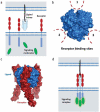Concepts for agonistic targeting of CD40 in immuno-oncology
- PMID: 31403344
- PMCID: PMC7062441
- DOI: 10.1080/21645515.2019.1653744
Concepts for agonistic targeting of CD40 in immuno-oncology
Abstract
TNF Receptor Superfamily (TNF-R-SF) signaling is a structurally well-defined event that requires proper receptor clustering and trimerization. While the TNF-SF ligands naturally exist as trivalent functional units, the receptors are usually separated on the cell surface. Critically, receptor assembly into functional trimeric signaling complexes occurs through binding of the natural ligand unit. TNF-R-SF members, including CD40, have been key immunotherapeutic targets for over 20 years. CD40, expressed by antigen-presenting cells, endothelial cells, and many tumors, plays a fundamental role in connecting innate and adaptive immunity. The multiple investigated strategies to induce CD40 signaling can be broadly grouped into antibody-based or CD40L-based approaches. Currently, seven different antibodies and one CD40L-based hexavalent fusion protein are in active clinical trials. In this review, we describe the biology and structural properties of CD40, requirements for agonistic signal transduction through CD40 and summarize current attempts to exploit the CD40 signaling pathway for the treatment of cancer.
Keywords: CD40; CD40L; HERA ligands; TNF-R-SF; agonist; cancer; immunotherapy.
Figures


References
Publication types
MeSH terms
Substances
LinkOut - more resources
Full Text Sources
Other Literature Sources
Medical
Research Materials
